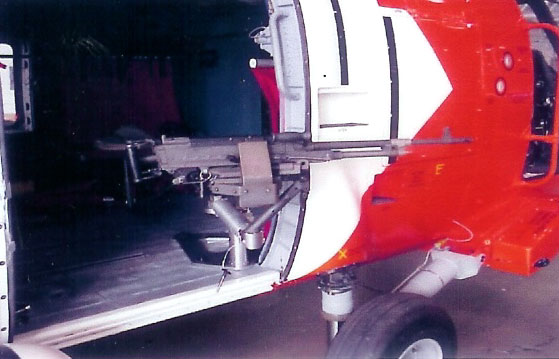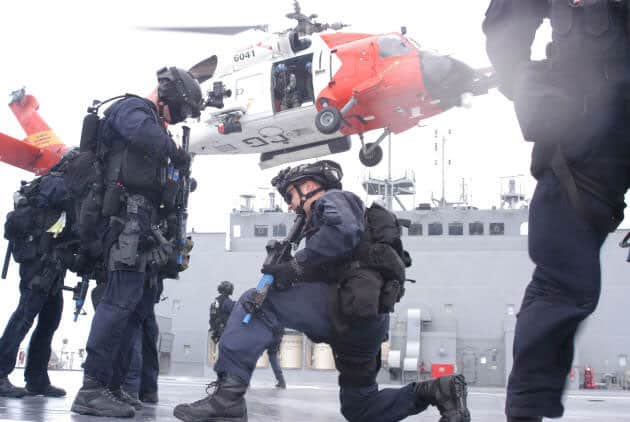In 1998 the U.S. Coast Guard established a unit known as HITRON-10 to test and evaluate airborne use of force (AUF) as a means of interdicting and stopping the high speed smuggling boats known as ‘go-fasts.” Tactics were developed using leased MD-90 helicopters. After a successful proof of concept operation HITRON was established as a permanent Coast Guard unit. In 2000, it transitioned to the Agusta A109, which was given the military designation MH68A Stingray. This was initially opposed by some within the service.
After the 9/11 attack the HITRON mission was expanded to anti-terrorist security operations. With the transfer to the Department of Homeland Security and the Coast Guard’s expanding role in maritime security and law enforcement a program to arm Coast Guard helicopters was initiated.
The Coast Guard sought help from the Naval Air Systems Command (NAVAIR) to design and install flexible mounts for machine guns on the helicopters. NAVAIR’s Coast Guard project coordinator, Robert Blevins, took on the task of designing, installing, and testing gun mounts for the helicopters. Blevins had extensive experience with rotary wing aircraft and had seen many gun mounts installed on Navy helicopters. He knew the work could be accomplished at Patuxent River with some help from the Naval Surface Warfare Center at Crane, Indiana.
Nick Patregnani, an engineer assigned to NAVAIR’s Air Vehicle/Store Compatibility Division, served as lead test engineer for the installation of M240D machine gun mounts for the HH-60J and HH-65B. “One unique aspect of this testing was that the HH-65 is a commercial aircraft, so it was not built for arming,” Patregnani said. “There was never the intent for that until now. It presented an interesting challenge for us.” Because of a common airframe design with the Navy HH-60H armed helicopter the design of a gun mount for the HH-60J was less complicated.

NAVAIR’s testing of the armed HH-60J and HH-65B included ground fit tests, ground test firing, captive-carriage-of-fire tests, and in-flight live-fire tests. NAVAIR engineers also added flashing blue lights to the helicopters, as well as night lighting on the aircraft to illuminate the Coast Guard logo.
The first armed HH60 Jayhawk was tested at Elizabeth City at the end of 2003 and in March of 2004 four were assigned to the Cape Cod air station for proof of concept exercises. They were equipped with an airframe mounted area-fire FN-240 machine gun, a shoulder mounted weapon, upgraded radios, upgraded FLIR, heads up display, cabin floor armor, and pilot and copilot seat armor. A selected group of pilots and flight crew were trained in day and night tactics and aerial gunnery. Lessons learned were applied to the on-going arming of the HH-60J and conversion to the MH-60T. The Jayhawk also has vertical insertion capability.
In the case of the HH-65B, the identified need for airborne use of force capabilities in addition to the installation of FLIR, satellite communications and an improved radar system, required more power. The HH-65B was re-engined with the Turbomeca Arriel 2C2. Adding airborne use of force capabilities to a HH-65 was delayed until after the engine upgrade. The first unit to get the HH-65 with upgraded engines was Air Station Atlantic City in April of 2005. The last of 95 HH-65s completed the re-engining in October of 2007. The re-engined aircraft was designated a HH-65C. The HH-65C is configured and pre-wired to allow for the installation and removal of AUF weapons, armor, EO/IR, and HUD equipment.

During 2002 an evaluation of both the HH-60J and HH-65A as Vertical Insertion platforms of law enforcement teams was conducted. The concept was non-lethal boardings with force back up. As the Coast Guard’s security mission continued to expand the concept evolved into vertical insertion, “fast roping,” of Maritime Security Response Teams (MRST) which are specialized tactical forces of the US Coast Guard. MSRT are highly trained units capable of conducting helicopter insertions against armed hostiles, scuba operations, and can storm disputed oil platforms or ships. The HH-60 is used for the vertical insertion operations.
In July of 2007 the Coast Guard assumed the responsibility for air intercept operations in the Washington D.C. area. Coast Guard MH-65C helicopters are responsible for intercepting unauthorized aircraft which fly into an air defense identification zone surrounding the nation’s capital.
In 2008 the MH-65C helicopters replaced the MH68A Stingray helicopter for HITRON operations.
Funding was made available and it is planned to provide airborne force capabilities to all of the Coast Guard helicopters. The organic AUF rollout plans called for a number of air stations to be trained and armed by the end of FY 2009. The military mission aspect of Coast Guard aviation is now greater than at any time since World War II. As the Coast Guard continues to meet present and future challenges it is expected that the emphasis on the military mission of the Coast Guard will depend upon circumstances and the viewpoint of the sitting Commandant – much the same as in the past.

